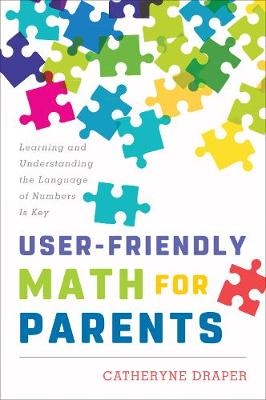
User-Friendly Math for Parents
Rowman & Littlefield (Verlag)
978-1-4758-3419-2 (ISBN)
This book focuses more on the “why” reasons behind math number relationships, explained in plain English and with images that show number relationships. By including more images and fewer formulas, readers – especially the visual spatial learners – have a better chance of understanding how number organizers apply to different number types. Recognizing connections among number formats significantly reduces the impatience, frustration, and heartache around homework.
Catheryne Draper has been learning from her students for over half a century of teaching, supervising the math program in a school district, advising math education at the state level, coaching math in schools, and presenting math workshops for teachers. She is the author of The Algebra Game, a hands-on multi-deck algebra program in four topics covering Linear Graphs, Quadratic Equations, Conic Sections, and Trig Functions that allows students to work together in cooperative groups, or individually, to identify the algebra relationships and patterns in the each topic and in the organization across the topics. In addition to contributing many published articles, Draper is also the author of Winning the Math Homework Challenge: Insights for Parents To See Math Differently.
Preface
Foreword
Introduction
Part I: Definition
1. Getting a Grip on Number Sense
Number Freedom
Flexibility Through Composition and Decomposition of Numbers
How Counting Can Make or Break Number Sense
Ducks, Gauss, and George
Keep in Mind
2. The Map of Number Symbol Territory
The Shapes of Reading Numbers
Is Subitizing About Another Shape to Recognize?
Alphabet of Letters and Alphabet of Digits
Writing Numbers and Reading Symbolism
Keep in Mind
3. An Evolution of Number and Naming Rights
Counting (Natural), and Whole Numbers
Integers and Other Positive and Negative Absurd Numbers
Rational Numbers Include Fractions and Other Number Comparisons
Politics of Rational and Unutterable Irrational Numbers
Infinity, Googol, and Other Very Large Ideas
Keep in Mind
Part II: Organization
4. Classify First
Three Is Not Red
Classification as an Essential Skill
Different Classifications Lead to Increased Flexibility
Keep in Mind
5. Whence Came Place Value?
Digits Continue to be the Alphabet for Numbers
Some Cautionary Tales About Learning Place Value
Classifying by Size for Place Value
Transitioning to Place Value Record-Keeping
Charles’ Overlays
Decimals Continue the Same Organization, Just Smaller
Keep in Mind
6. The Number Line Brings Numbers to Order
First, Last, and In Between – The Nature of Order
Repetition of Pattern in Sequential Order
A Place for Everything
Keep in Mind
Part III: Relationships and Patterns
7. Pattern Ancestors
Repeating Patterns
Growing Patterns
Ancestors of Figurate Numbers and Other Growing Patterns
Patterns Inside EquivalencesExpressing Ancestral Rules as Algebra Relationships
Keep in Mind
8. Balance of Relationships and Patterns
Flexibility Within Balance
Balance in Fraction Equivalences
Decimal Numbers Are Connections to the Other Side
Finding Patterns With ViewfindersKeep in Mind
9. Number Personalities
Even and Odd Numbers
Prime and Composite Numbers
Positive and Negative Integers
Numbers Can Have Multiple Number Personalities
Keep in Mind
Part IV: Connections
10. Place Value LegaciesExponents and Logarithms
Location Matters
Reciprocals: A Location and an Inverse
Who Moved My Decimal?
Keep in Mind
11. Ratio: The Comparison Effect
Predicaments Around Understanding Fraction as a Ratio Notation
Ratio Pairs Can Make Proportions
Percentage: A Location and a Rate
Keep in Mind
12. More Order From the Number Line
Number Lines Are Everywhere
Coordinate Axes
More Coordinate Connections
Keep in Mind
Conclusion: What Parents Can Do
Ask Questions
Advocate for Number Sense
Find Your Math Voice
Keep in Mind
Glossary
References
About the Author
| Erscheinungsdatum | 10.06.2017 |
|---|---|
| Verlagsort | Lanham, MD |
| Sprache | englisch |
| Maße | 184 x 263 mm |
| Gewicht | 567 g |
| Themenwelt | Sachbuch/Ratgeber ► Gesundheit / Leben / Psychologie ► Familie / Erziehung |
| Schulbuch / Wörterbuch | |
| Sozialwissenschaften ► Pädagogik | |
| ISBN-10 | 1-4758-3419-5 / 1475834195 |
| ISBN-13 | 978-1-4758-3419-2 / 9781475834192 |
| Zustand | Neuware |
| Haben Sie eine Frage zum Produkt? |
aus dem Bereich


